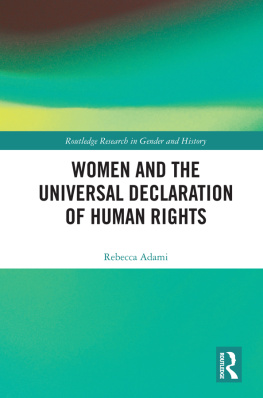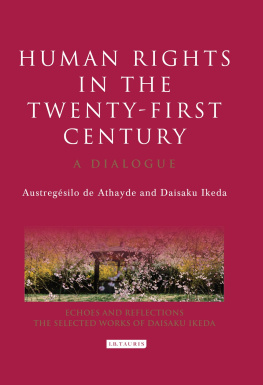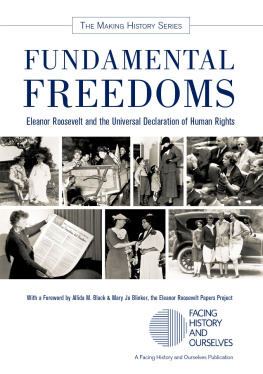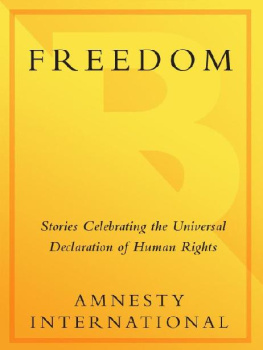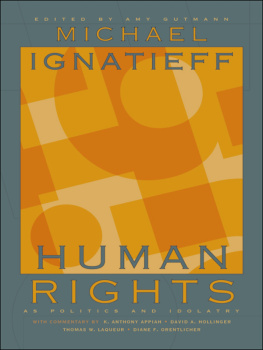Contents
Guide
Pagebreaks of the print version
Also by Johannes Morsink
The Universal Declaration of Human Rights: Origins, Drafting and Intent (1999)
Inherent Human Rights: Philosophical Roots of the Universal Declaration (2009)
The Universal Declaration of Human Rights and the Challenge of Religion (2017)
The Universal Declaration of Human Rights and the Holocaust: An Endangered Connection (2019)
Article by Article
The Universal Declaration of Human Rights for a New Generation
Johannes Morsink
PENN
University of Pennsylvania Press
Philadelphia
Copyright 2022 University of Pennsylvania Press
All rights reserved. Except for brief quotations used for purposes of review or scholarly citation, none of this book may be reproduced in any form by any means without written permission from the publisher.
Published by
University of Pennsylvania Press
Philadelphia, Pennsylvania 19104-4112
www.upenn.edu/pennpress
Printed in the United States of America on acid-free paper
10987654321
Library of Congress Cataloging-in-Publication Data
Names: Morsink, Johannes, author.
Title: Article by article : the Universal Declaration of Human Rights for a new generation / Johannes Morsink.
Other titles: Pennsylvania studies in human rights.
Description: 1st edition. | Philadelphia : University of Pennsylvania Press, [2022] | Series: Pennsylvania studies in human rights | Includes index.
Identifiers: LCCN 2021019352 | ISBN 9780812253504 (hardcover)
Subjects: LCSH: United Nations. General Assembly. Universal Declaration of Human Rights. | Human rights.
Classification: LCC K3238.31948 .M663 2021 | DDC 341.4/8dc23
LC record available at https://lccn.loc.gov/2021019352
ISBN 978-0-8122-5350-4
History, despite its wrenching pain, cannot be unlived, but if faced with courage need not be lived again.
Maya Angelou
Pennsylvania Studies in Human Rights
Bert B. Lockwood, Series Editor
A complete list of books in the series is available from the publisher.
Contents
Preface
You may or may not be familiar with what the Universal Declaration of Human Rights (UD) looks like or how it is organized. It is quite a simple document, starting out with seven recitals in which the drafters give us their reasons for proclaiming this text on December 10, 1948. Then we read in the operative paragraph that education is the purpose of this proclamation, which is also the main reason I wrote this brief article-by-article commentary. After that come the thirty articles of this famous text, some of which my reader may be familiar with, many probably not. So the UD has three parts to it: a preamble, a statement of purpose, and thirty articles.
Throughout, the reader will discover that the declarations drafters were in a militant mood that went beyond simply educating the public on what human rights it has. They also wanted to enlist people to help them beat back future attacks of Hitlerian authoritarianism and illiberal populism, which theme I will refer to as a battle or a fighting back with human rights as our weapons of choice. After they had won World War II militarily, many UD drafters saw themselves as part of a continuing ideological warfare between democratic states and authoritarian regimes. That is how most North Atlantic and Latin American nations and their friends saw the fight. Communists were also happy to see fascism defeated, but they were not afraid of their own kind of authoritarianism, which they referred to as democratic socialism, but which was not at all what we today mean by that phrase. The Nordic model of political and economic organization is nothing like the one-party totalitarianism that communist UD drafters were pushing. However, their drafting colleagues resisted these communist attempts to inject a strong role for the authoritarian or absolutist state into the text of the declaration. Those other drafters wanted the UD to stand in judgment over national legal systems, something the communists resisted. The reader will detect this tension everywhere, in the preamble as well as in many of the thirty articles.
I have written this book not just to tell you that the UD drafters were worried about a recurrence of Hitlers fascism and communist authoritarianism of the 1930s, 1940s, and 1950s. I wrote it also to enlist you in the combat against a recurrence of these movements today in the different countries we call home. I have in mind the intellectual climate of our own day as painted by authors like Timothy Snyder in his On Tyranny: Twenty Lessons from the Twentieth Century and Anne Applebaum in her Twilight of Democracy: The Seductive Lure of Authoritarianism. These authors have summarized decades of their research in slim volumes that help us understand the dangerous times in which we live.
Applebaum tells us how she experienced shifts toward authoritarianism in leading public figures on the ground in Poland, Egypt, Hungary, Turkey, the United Kingdom, France, Spain, Hong Kong, and, yes, the United States. Snyders last lesson from his twentieth-century research tells us, Be as courageous as you can. That fits the Maya Angelou epigraph I picked for this book: History, despite its wrenching pain, cannot be unlived, but if faced with courage need not be lived again. We do not want and cannot go back to the horrible dictatorial times of the 1930s, 1940s, and even 1950s. But if these authors are correct, that is the danger that Western democracy faces. Even the foundational values of our own country, the United States, are at stake in this fight. Readers who are aware of what happened in the Trump presidency will know about the hollowing out of every department of our government, with public norms and legal precedents being set aside on a daily basis. There is no telling how long it will take to heal this oldest of all democracies.
This book therefore asks you to put on the armor supplied by the Universal Declaration of Human Rights, to pick a human rights violation that enrages you, and go and do battle against that violation. I stretch the reasons behind the adoption of each article in this iconic text into a lesson for our own time and place. The UD drafters worried about the same dangers the aforementioned authors describe. They sharpened their resolves and used their pens to show us where the moral high ground is in our fight for the human-rights-based world order they bequeathed to us but that is now so obviously threatened.
Against this background of doing battle with authoritarianism and populism, each UD article also presented the narrower goal of protecting its own particular human right, however that right had been shaped in each nations domestic context. All these national human rights interests had to be universalized against the larger background of fighting off a recurrence of Nazism, fascism, sexism, colonialism, workers neglect, illiteracy and ignorance, and all types of discrimination. Also, workers knew that World War II was fought on their backs and they wanted their welfare taken care of in this declaration. Thus you will see a large union influence on the drafting of the economic and social human rights in the second half of the declaration. That second half reads like a veritable blueprint for the socialist half of todays democratic socialism, the democratic half of this equation having been set down in the first half of the UD text.



